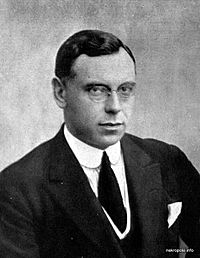Zigfrīds Anna Meierovics facts for kids
Quick facts for kids
Zigfrīds Anna Meierovics
|
|
|---|---|
 |
|
| 2nd Prime Minister of Latvia | |
| In office 19 June 1921 – 26 January 1923 |
|
| President | Jānis Čakste |
| Preceded by | Kārlis Ulmanis |
| Succeeded by | Jānis Pauļuks |
| In office 28 June 1923 – 26 January 1924 |
|
| President | Jānis Čakste |
| Preceded by | Jānis Pauļuks |
| Succeeded by | Voldemārs Zāmuēls |
| Foreign Minister of Latvia | |
| In office 18 November 1918 – 26 January 1924 |
|
| Prime Minister | Kārlis Ulmanis Jānis Pauļuks Himself |
| Preceded by | Position established |
| Succeeded by | Ludvigs Sēja |
| In office 18 December 1924 – 22 August 1925 |
|
| Prime Minister | Hugo Celmiņš |
| Preceded by | Ludvigs Sēja |
| Succeeded by | Hugo Celmiņš |
| Personal details | |
| Born | 5 February 1887 (part of the Russian Empire) |
| Died | 22 August 1925 (aged 38) |
| Resting place | Riga Forest cemetery |
| Political party | Latvian Farmers' Union |
| Spouse | Anna Meierovics (née Fielhold) |
| Children | Helmuts, Ruta, Gunars |
| Profession | Diplomat, Politician |
Zigfrīds Anna Meierovics (born February 5, 1887, in Durbe – died August 22, 1925, near Tukums) was an important Latvian politician. He was Latvia's first Foreign Minister, helping the country connect with others. He also served twice as the Prime Minister of Latvia. Meierovics was one of the people who started the Latvian Farmers' Union, which is one of Latvia's oldest political groups.
Contents
Early Life and Education
Zigfrīds Anna Meierovics was born in 1887. His father was a doctor and his mother, Anna, sadly passed away when he was born. His father became ill, so young Zigfrīds grew up with his uncle's family in Sabile.
He was a very smart student. He went on to study at the Riga Polytechnicum. This is a famous university in Latvia.
Political Career
After 1911, Meierovics became involved in many Latvian groups. During World War I, he worked to help Latvian refugees. He also helped organize the Latvian Riflemen units, who were brave soldiers.
After a big change in Russia called the February Revolution, he moved to Riga. There, he started working as a full-time politician. In September 1917, he attended an important meeting called the Congress of the Peoples of Russia.
Latvia's Independence
Meierovics played a key role in Latvia becoming an independent country. In late 1918, he spoke for the Latvian Provisional National Council. He got written proof that the United Kingdom recognized Latvia as a country. They also recognized the National Council as its government.
On November 19, 1918, just one day after Latvia declared its independence, Meierovics became the first Minister of Foreign Affairs. This was a very important job. He was also a member of the Latvian Peoples Council. Later, he joined the Constitutional Assembly of Latvia and the 1st Saeima, which are like Latvia's parliament.
Serving as Prime Minister
Zigfrīds Anna Meierovics served as the Prime Minister of Latvia two times. His first term was from June 1921 to January 1923. His second term was from June 1923 to January 1924. As Prime Minister, he helped lead the new country.
Awards and Recognition
Meierovics received many honors from different countries. These awards showed how much his work was valued.
- In 1922, he received the Grand Cross of the Polish Order of Polonia Restituta.
- He also received the Grand Cross of the Order of St. Sylvester from the Holy See.
- From Latvia, he was given the Order of the Three Stars, First Class.
- He also received the Order of the White Rose from Finland.
- France awarded him the Croix de guerre.
- Other awards included the Order of Lāčplēsis, 3rd class (Latvia), and the Austro-Hungarian Order of the Red Cross.
Personal Life
On September 28, 1910, Meierovics married Anna Fielhold. They had three children together: two boys named Helmuts and Gunars, and a girl named Ruta.
Later, in 1924, he and Anna divorced. He then married Kristīne Bakmane on June 7, 1924.
His son, Gunars, also became a politician. In 1993, Gunars was a candidate for President of Latvia. This was the first presidential election after Latvia became free from Soviet rule. However, the parliament chose Guntis Ulmanis instead.
Death
Zigfrīds Anna Meierovics died too young. He passed away in a car accident on August 22, 1925. He was only 38 years old. His death was a great loss for Latvia.

